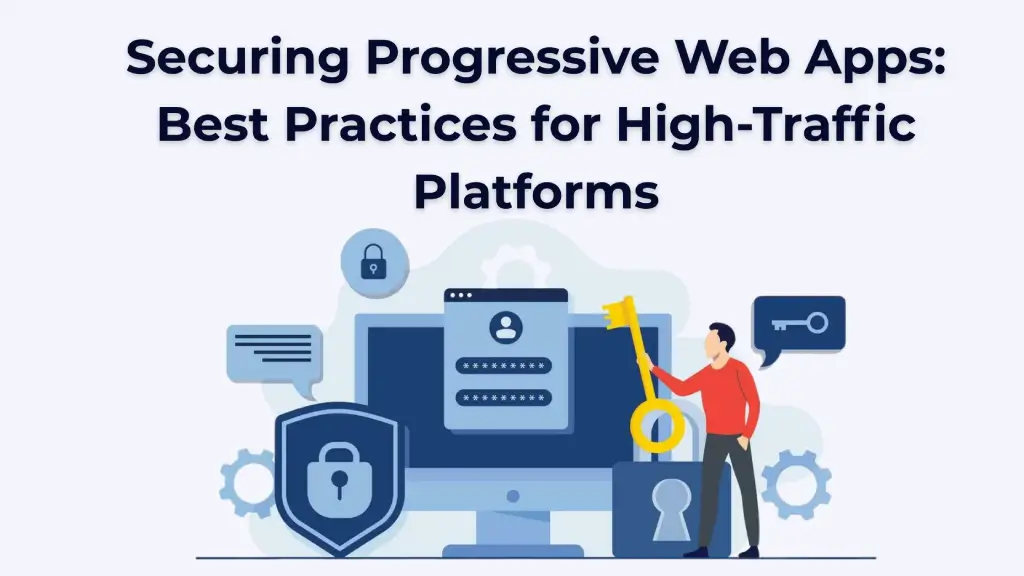Loading content...
- Software DevelopmentIT Consulting & DesignAI & Data SolutionsQuality AssuranceTeam & Resource SupportBusiness Support Services
When a flash sale starts, your checkout page suddenly has tens of thousands of sessions at the same time. If your service worker or API layer isn’t set up correctly, you risk downtime, data leaks, and reputation damage. This post covers how React-based PWAs with .NET 8 backends can mitigate risks, enforce security layers, and scale safely under heavy load—while staying fast and reliable.
Covers XSS, CSRF, insecure service workers, API exposure, and dependency flaws.
Enforce HTTPS & HSTS, apply strict CSP, secure cookies, and sanitize inputs.
Add rate limiting, DDoS protection, zero-trust policies, and real-time monitoring.
Loading content...
Let's discuss your project and create a custom web application that drives your business forward. Get started with a free consultation today.

When a flash sale starts, your checkout page suddenly has tens of thousands of sessions going on at the same time. Requests go over the roof, caches get overloaded, and an attacker tries to sneak into an unprotected endpoint. If you don't set up your service worker or API layer correctly, you could have downtime, data leaks, and damage to your reputation.
PWAs are currently used by everything from big retail stores to SaaS platforms, but because they have a bigger attack surface and more worldwide traffic, security is a must-have for your architecture.
This article is for PWAs that use React and have .NET 8 backends. It has useful information and advice for developers, architects, and product owners on how to keep their high-traffic platforms safe while keeping them fast and reliable.
High traffic magnifies small security flaws. Here are the top vulnerabilities to address:
Here's the content reformatted into a clean, developer-friendly table:
| Vulnerability | Risk | Mitigation |
|---|---|---|
| Cross-Site Scripting (XSS) | Malicious scripts injected into pages or cached offline. | Enforce strict Content Security Policy (CSP), sanitize user input, and escape output in React components. |
| Cross-Site Request Forgery (CSRF) | Unauthorized actions triggered from authenticated browsers. | Use anti-forgery tokens for state-changing requests and SameSite=Strict cookies. |
| Insecure Service Workers | Broad scope or outdated workers allowing malicious interception. | Restrict scope, enforce HTTPS, and regularly audit service-worker logic. |
| API Exposure and Weak Authentication | Unprotected endpoints leaking data or allowing brute-force abuse. | Use JWT-based authentication, implement rate limiting, and apply role-based access control (RBAC). |
| Dependency Vulnerabilities | Outdated libraries (npm or NuGet) with known CVEs. | Automate dependency scanning and lock versions in CI/CD pipelines. |
Secure the foundation:
1
2
3
# Enforce HTTPS + HSTS
add_header Strict-Transport-Security "max-age=31536000; includeSubDomains; preload" always;
In React:
1
2
3
4
5
{if (location.protocol !== 'https:' || !('serviceWorker' in navigator)) {
console.warn('Service workers require HTTPS.');
} else {
navigator.serviceWorker.register('/sw.js', { scope: '/app/' });
}Content-Security-Policy:
1
2
3
4
5
6
7
8
default-src 'self';
script-src 'self' https://cdn.example.com;
style-src 'self' 'unsafe-inline';
img-src 'self' data: https://images.example-cdn.com;
connect-src 'self' https://api.example.com wss://push.example.com;
object-src 'none';
base-uri 'self';
frame-ancestors 'none';
Secure; HttpOnly; SameSite=Strict for session cookies.1
2
3
4
5
6
import DOMPurify from 'dompurify';
export default function SafeHtml({ html }) {
const safe = DOMPurify.sanitize(html, { USE_PROFILES: { html: true } });
return <div dangerouslySetInnerHTML={{ __html: safe }} />;
}
1
navigator.serviceWorker.register('/sw.js', { scope: '/app/' });1
2
3
4
5
6
7
8
9
10
11
12
13
14
15
16
17
18
self.addEventListener('fetch', (event) => {
const { request } = event;
const url = new URL(request.url);
if (request.method !== 'GET' || url.pathname.startsWith('/api/secure')) return;
event.respondWith((async () => {
const cache = await caches.open('static-v1');
const cached = await cache.match(request);
if (cached) return cached;
const resp = await fetch(request, { cache: 'no-store' });
if (resp.ok && (resp.headers.get('Cache-Control') || '').includes('public')) {
cache.put(request, resp.clone());
}
return resp;
})());
});Use short-lived JWTs with refresh token rotation:
1
2
3
4
5
6
7
8
9
10
11
12
13
14
15
16
17
18
var jwt = new JwtSecurityToken(
issuer: jwtIssuer,
claims: claims,
expires: DateTime.UtcNow.AddMinutes(10),
signingCredentials: creds
);
var token = new JwtSecurityTokenHandler().WriteToken(jwt);
Restrict sensitive routes:
app.MapGet("/api/secure/profile", (ClaimsPrincipal user) =>
{
return Results.Json(
new { userId = user.Identity?.Name },
contentType: "application/json",
statusCode: 200,
headers: new() { ["Cache-Control"] = "no-store" }
);
}).RequireAuthorization();Protect APIs from abuse:
1
2
3
4
5
6
7
8
9
builder.Services.AddRateLimiter(options =>
{
options.AddFixedWindowLimiter("api", o =>
{
o.Window = TimeSpan.FromMinutes(1);
o.PermitLimit = 300; // 300 requests per minute
o.QueueLimit = 50;
});
});Return token to SPA
1
2
3
4
5
app.MapGet("/api/csrf-token", (IAntiforgery af, HttpContext ctx) =>
{
var token = af.GetAndStoreTokens(ctx).RequestToken;
return Results.Ok(new { csrfToken = token });
});1
2
3
4
5
6
7
export async function subscribeToPush(vapidKey) {
const reg = await navigator.serviceWorker.ready;
return reg.pushManager.subscribe({
userVisibleOnly: true,
applicationServerKey: Uint8Array.from(atob(vapidKey), c => c.charCodeAt(0))
});
}HTTPS alone can't keep a progressive web app (PWA) made with React and .NET 8 safe. Having a lot of different levels of protection is important, like a strict CSP, service workers with a clear scope, secure APIs, and regular testing.
Once you've established HTTPS and CSP, you need to set up CI/CD to perform automatic scans. Make it even bigger by adding operational protections like WAFs, DDoS protection, and real-time monitoring. By adding safety to your DevOps process, you might create a platform that is useful, legal, and safe for people all over the world to use.
Is your high-traffic PWA truly secure against XSS, CSRF, and API abuse?
Book a free chat with Moltech Solutions Inc.—get practical steps to lock down your React + .NET 8 platform with HTTPS, CSP, scoped workers, and secure APIs.
Let's connect and discuss your project. We're here to help bring your vision to life!